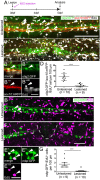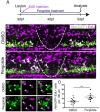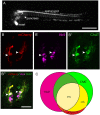Spinal motor neurons are regenerated after mechanical lesion and genetic ablation in larval zebrafish
- PMID: 26965370
- PMCID: PMC4986163
- DOI: 10.1242/dev.129155
Spinal motor neurons are regenerated after mechanical lesion and genetic ablation in larval zebrafish
Abstract
In adult zebrafish, relatively quiescent progenitor cells show lesion-induced generation of motor neurons. Developmental motor neuron generation from the spinal motor neuron progenitor domain (pMN) sharply declines at 48 hours post-fertilisation (hpf). After that, mostly oligodendrocytes are generated from the same domain. We demonstrate here that within 48 h of a spinal lesion or specific genetic ablation of motor neurons at 72 hpf, the pMN domain reverts to motor neuron generation at the expense of oligodendrogenesis. By contrast, generation of dorsal Pax2-positive interneurons was not altered. Larval motor neuron regeneration can be boosted by dopaminergic drugs, similar to adult regeneration. We use larval lesions to show that pharmacological suppression of the cellular response of the innate immune system inhibits motor neuron regeneration. Hence, we have established a rapid larval regeneration paradigm. Either mechanical lesions or motor neuron ablation is sufficient to reveal a high degree of developmental flexibility of pMN progenitor cells. In addition, we show an important influence of the immune system on motor neuron regeneration from these progenitor cells.
Keywords: Dopamine; Hb9; Macrophage; Microglia; Nitroreductase; Olig2; Sox10.
© 2016. Published by The Company of Biologists Ltd.
Conflict of interest statement
The authors declare no competing or financial interests.
Figures








References
Publication types
MeSH terms
Substances
Grants and funding
LinkOut - more resources
Full Text Sources
Other Literature Sources
Medical
Molecular Biology Databases

